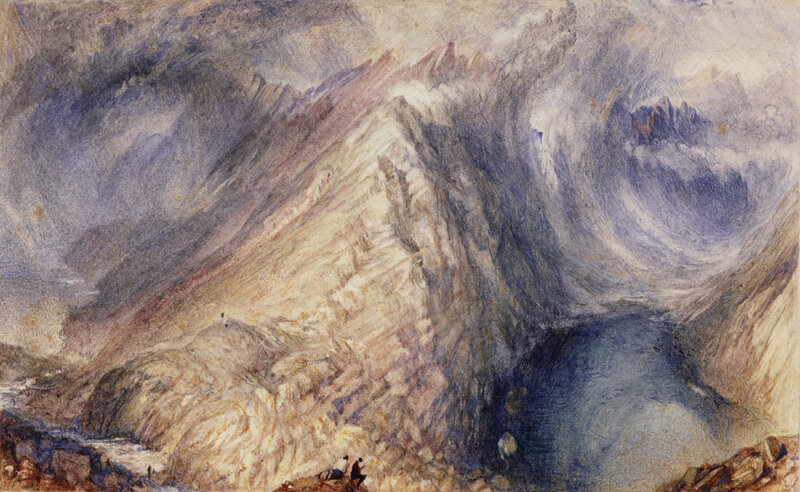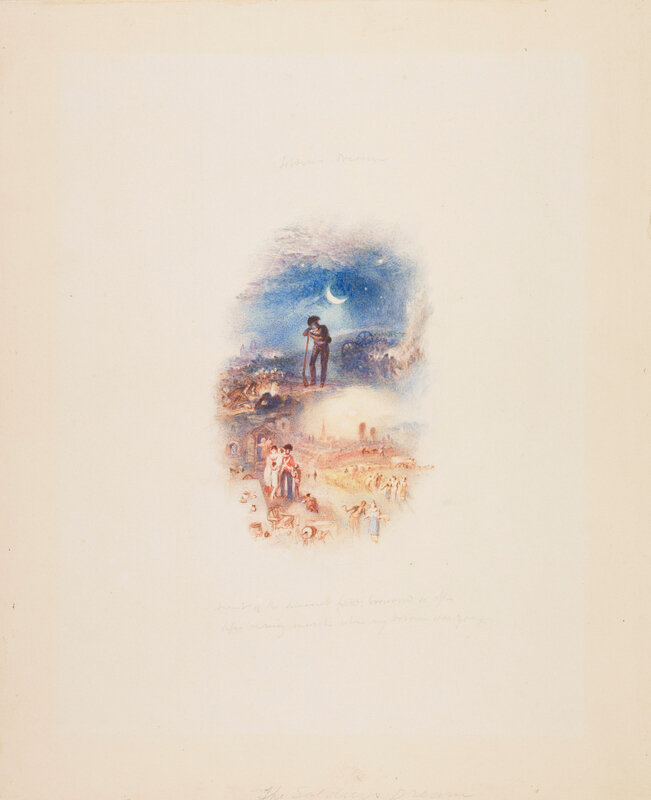Turner in January 2020 at the Scottish National Gallery
J. M. W. Turner (1775-1851), Loch Coruisk, Skye, 1831. Watercolour with scraping on paper, 8.90 x 14.30 cm. Collection: Scottish National Gallery, Henry Vaughan Bequest 1900. Photo: © National Galleries of Scotland | Antonia Reeve.
EDINBURGH.- In 1900, collector Henry Vaughan made an exceptional bequest to the National Galleries of Scotland – a set of 38 radiant watercolours by Joseph Mallord William Turner, giving a gift to the nation to be enjoyed for generations.
This annual exhibition has become a celebrated tradition and a feature to look forward to on New Year’s Day and the month of January for locals and tourists alike. The relatively fleeting glimpse is a joy and a privilege as these paintings are by one of Britain’s most celebrated artists and are in such spectacular condition due to the conditions of the bequest. In 2020, this much-loved annual exhibition is supported by players of People’s Postcode Lottery for the seventh year.
J. M. W. Turner (1775-1851), The Piazzetta, Venice, 1840. Watercolour and gouache and pen and ink, with scraping out on paper, 22.1 x 32.1 cm. Collection: Scottish National Gallery, Henry Vaughan Bequest 1900. Photo: © National Galleries of Scotland | Antonia Reeve.
In addition to the 38 bequeathed works, this year the exhibition will also feature a very fine watercolour on long loan to the Gallery from a private collection. Virginia Water is one of a pair of views of the royal pleasure grounds and grand artificial lake in Windsor Great Park executed by Turner in about 1829, probably in the hope of attracting the patronage of King George IV. It depicts the King’s magnificent, opulent Royal barge on the lake, with the recently built ‘Chinese Fishing Temple’, designed by the architect Jeffry Wyatville, shown in the background.
Aware that limited exposure would preserve the brilliant colour and exceptional condition of the works, Vaughan stipulated that the Turners should only ever be shown during January, an especially dark time of year in Scotland, when light levels are particularly weak. Watercolours are particularly susceptible to damage – exposure to sunlight or a very bright room with reflected light can rapidly fade the pigments and the paper may also become bleached or yellowed.
J. M. W. Turner (1775-1851), Sea View, About 1826. Bodycolour on blue paper, 13.50 x 19.00 cm. Collection: Scottish National Gallery, Henry Vaughan Bequest 1900. Photo: © National Galleries of Scotland | Antonia Reeve.
Henry Vaughan was 21 when he inherited his fortune from his father, who had been a wealthy milliner. Vaughan devoted himself to travel, collecting fine and decorative art. He also became known for his philanthropy and as a distinguished and astute collector, most notably for nineteenth-century British art, in particular Turner and Constable.
The full conditions stipulated were that the Turners were “to be exhibited to the public all at one time free of charge during the month of January in every year … and no longer time in every year”.
J. M. W. Turner (1775-1851), Durham, 1801. Watercolour over pencil on paper, 40.90 x 25.00 cm. Collection: Scottish National Gallery, Henry Vaughan Bequest 1900. Photo: © National Galleries of Scotland | Antonia Reeve.
Inspired by the great critic John Ruskin (1819-1900), who had presented a group of Turner watercolours to the Fitzwilliam Museum in Cambridge in 1861, Vaughan wished to make his collection widely accessible to the public. In addition to the famous stipulations in his will he also specified that the drawings should be housed in a purpose built cabinet and made available to anyone who wished to study them throughout the rest of the year, a tradition that continues to this day. Education was extremely important to Vaughan; he personally selected the watercolours for each of his parallel bequests to Edinburgh and Dublin, ensuring that a representative selection of watercolours spanning Turner’s fifty year career went to each national gallery, allowing the public to see and appreciate the full and diverse range of Turner’s work. Despite the fact that Turner visited Scotland on six occasions and was profoundly inspired by the Scottish landscape, in the 1890s his work was little seen there. It’s likely that Vaughan would have known that his bequest would transform the representation of Britain’s most celebrated landscape painter in Scotland.
J. M. W. Turner (1775-1851), One of Twenty Vignettes - The Soldier's Dream, About 1835. Watercolour over pencil on paper, 11.50 x 8.00 cm. Collection: Scottish National Gallery. Accepted by HM Government in lieu of inheritance tax and allocated to the National Gallery of Scotland, 1988. Photo: © National Galleries of Scotland | Antonia Reeve.
Born in London in 1775, the son of a barber and wig-maker, Turner proved himself as an accomplished draughtsman at an early age, exhibiting works at the Royal Academy by the age of 15. He was a prolific, innovative and energetic artist, employing every possibility of watercolour as a medium, travelling widely to capture stunning land- and seascapes. Turner initially began his travels with sketching tours in England, Wales and Scotland, then later across Europe, where he gathered material for masterful watercolours and oil paintings and made annual visits across the Channel for much of the rest of his life.
J. M. W. Turner (1775-1851), One of Twenty Vignettes - Kosciusko (Illustration to 'The Pleasures of Hope'), About 1835. Watercolour over pencil on paper, 11.50 x 11.20 cm (framed: 45.10 x 39.70 x 2.80 cm). Collection: Scottish National Gallery. Accepted by HM Government in lieu of inheritance tax and allocated to the National Gallery of Scotland, 1988. Photo: © National Galleries of Scotland | Antonia Reeve.
The exquisite works in the Vaughan bequest range from early wash drawings of the 1790s, to the colourful, atmospheric and wonderfully expressive late works executed on visits to the Swiss Alps during the 1830s and 1840s. It was Turner’s habit as an artist to fill sketchbooks while on tours in the summer from which to work up to finished watercolours. Other highlights of the bequest include a series of spectacular views of Venice such as The Piazzetta, Venice and Venice from the Laguna, which capture the drama and explosive skies of late summer Adriatic storms and demonstrate the artist’s consummate mastery of atmospheric lighting effects.
The exquisite works in the Vaughan bequest range from early wash drawings of the 1790s, to the colourful, atmospheric and wonderfully expressive late works executed on visits to the Swiss Alps during the 1830s and 1840s. It was Turner’s habit as an artist to fill sketchbooks while on tours in the summer from which to work up to finished watercolours. Other highlights of the bequest include a series of spectacular views of Venice such as The Piazzetta, Venice and Venice from the Laguna, which capture the drama and explosive skies of late summer Adriatic storms and demonstrate the artist’s consummate mastery of atmospheric lighting effects.
J. M. W. Turner (1775-1851), One of Twenty Vignettes - Kosciusko (Illustration to 'The Pleasures of Hope'), About 1835. Watercolour over pencil on paper, 11.50 x 11.20 cm (framed: 45.10 x 39.70 x 2.80 cm). Collection: Scottish National Gallery. Accepted by HM Government in lieu of inheritance tax and allocated to the National Gallery of Scotland, 1988. Photo: © National Galleries of Scotland | Antonia Reeve.
Stephanie Kerr, Programmes Advisor at People’s Postcode Lottery, said: “We’re so pleased that players of People’s Postcode Lottery are supporting this beloved annual exhibition for the 7th year in a row. We hope as many people as possible will join us in celebrating the beginning of a new year with a visit to Turner in January.”
Christopher Baker, Director of European and Scottish Art and Portraiture at the National Galleries of Scotland said: “The Vaughan Turners bring a welcome burst of light and colour into the dull days of an Edinburgh January. They also have the distinction of being the focus of the longest-running single artist exhibition in the world, having been displayed every winter since the early twentieth century.”
The display runs throughout January, providing a tranquil departure from the exuberant celebrations of Hogmanay and a welcome injection of light and colour in the depth of winter.

/https%3A%2F%2Fprofilepics.canalblog.com%2Fprofilepics%2F1%2F0%2F100183.jpg)
/https%3A%2F%2Fstorage.canalblog.com%2F03%2F02%2F119589%2F96711876_o.jpg)
/https%3A%2F%2Fstorage.canalblog.com%2F11%2F31%2F119589%2F94773502_o.jpg)
/https%3A%2F%2Fstorage.canalblog.com%2F20%2F83%2F119589%2F94772815_o.jpg)
/https%3A%2F%2Fstorage.canalblog.com%2F26%2F72%2F119589%2F75604929_o.jpg)
/https%3A%2F%2Fstorage.canalblog.com%2F59%2F60%2F119589%2F26458628_o.jpg)









/http%3A%2F%2Fstorage.canalblog.com%2F68%2F00%2F119589%2F126922270_o.jpg)
/http%3A%2F%2Fstorage.canalblog.com%2F10%2F65%2F119589%2F122356758_o.jpg)
/http%3A%2F%2Fstorage.canalblog.com%2F58%2F26%2F119589%2F69313478_o.jpg)
/image%2F1371349%2F20240426%2Fob_dcd32f_telechargement-32.jpg)